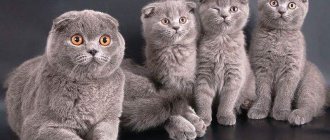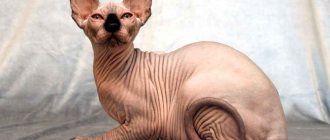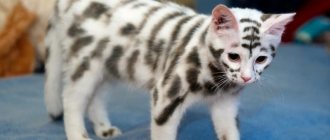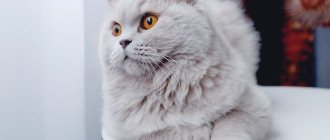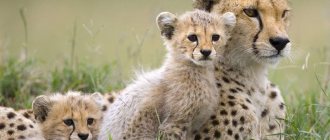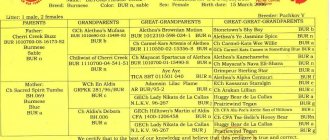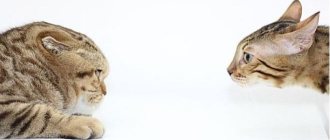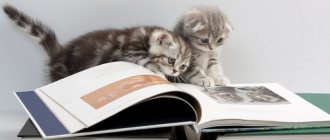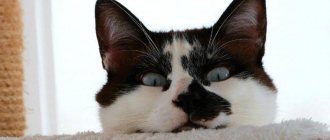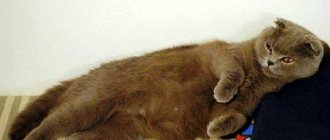History of the tricolor color
Few facts have been preserved in history about the origin of this unusual color, mostly speculation and assumptions.
Most likely, this rare color arose and became established as a result of a spontaneous gene mutation.
Scientist Neil Todd, studying the migration of secondarily domesticated cats along the trade routes of Europe and North Africa, suggested that the homeland of such individuals is Ancient Egypt. It was from there that they came along with ships to the port cities of Italy and France and spread first throughout all European countries, and then throughout the world.
Biologists Murray Barr and Bertram began closely studying the tricolor or “tortoiseshell” color in 1948. They discovered that the female nerve cells contained rod-shaped black bodies called Barr bodies. This feature was not observed in males.
Ten years later, the Japanese geneticist Ono Susumu established that “Barr bodies” are nothing more than chromosomes of the female type - X. Marie Lyon, continuing his work, developed the concept of inactivation of this chromosome in females.
Genetics of calico cats
The pigment melanin, which has two varieties - eumelanin and pheomelanin, is responsible for the color of the skin, eyes, and fur of cats. The first carries the gene for black color and its varieties - lilac, chocolate, blue.
Pheomelanin is responsible for all shades of red color. Since melanin is contained in the female X chromosome, the inheritance of coat color depends on the female.
In any mammals, including cats, females have a pair of chromosomes of the XX type, and males have an XY pair. Since the male has one X chromosome, he carries the gene for either black or red.
A cat has two X chromosomes and is therefore a red, black or mixed red and black (tortoiseshell) color.
The red color gene is called O (Orange). It is passed on from mother to son. A red cat can never give birth to a black male kitten, and a black female will not be the mother of a red cat.
Therefore, in nature there are only three-colored cats; tortoiseshell cats are almost never found in cats. Rare cases of the birth of such individuals are explained by genetic abnormalities.
A cat with fur of three colors (red-white-black) or two (red-black) will have an abnormal set of chromosomes - XXY. Almost always such males are fertile.
Of all mammals, only cats and Syrian hamsters have the Orange gene. The dominant O allele blocks the synthesis of black eumelanin and only red pheomelanin is formed - a red animal is born. If only the recessive allele is present, then eumelanin blocking does not occur and a black animal is born. Only one X chromosome is always linked to a gene, the second is inactive.
The O allele was discovered by geneticists only in 2010, while little is known about the intricacies of its action; research continues.
The S gene is responsible for white color; it is not associated with gender. There is a lot of white color in the color with the homozygous SS genotype, and less with the heterozygous Ss genotype.
BRITISH CATS WITH WHITE: TYPES OF COLOR
British cats with white in the color coding are supplemented by the number 01 - van, 02 - harlequin, 03 - bicolor - this is the relationship between the white color in the color and its quantity. There are the following types of colors with white spotting:
- bicolor/van/harlequin classic;
- tortoiseshell tricolors (calico);
- bicolor/van/harlequin/tricolor tabby;
- bicolor/van/harlequin/smoky tricolors;
- bicolor/van/harlequin/tricolor color-point;
- mixed colors (bicolor tortoiseshell shaded, bicolor color-point veiled, etc.).
The eye color of the British in color with white is always golden (yellow).
PHOTO GALLERY WITH DIFFERENT COLOR OPTIONS WITH WHITE
Photo: British cat black and white - black harlequin (black harlequin) BRI n 02 | British chocolate bicolor BRI b 03 | British kitten blue bicolor BRI a 03 |
| Photo: British cat cinnamon bicolor BRI o 03 |
|
| Photo: British red harlequin BRI d 02 |
| Photo: British black and white – British kitten black van BRI n 01 |
Photo: British black silver tabby bicolor Bri ns 22 03 |
| British tricolor cat - black and red tortoiseshell harlequin with white BRI f 02 |
| Photo: British cat lilac harlequin BRI d 02 | Photo: British cat blue van BRI a 01 | Photo: chocolate smoky bicolor BRI bs 03 |
| Photo: British kitten black and red tortoiseshell marbled bicolor BRI f 22 03 | Photo: British chocolate smoky color-point bicolor BRI bs 04 33 | Photo: British cinnamon color-point bicolor BRI o 04 33 |
COLOR OF BRITISH CAT BICOLOR (color code 03)
A British bicolor cat should be covered in white from 1/3 to 1/2 of the animal's color. The white color should be present from the British head in the form of a regular triangle, which begins on the forehead and diverges in both directions, touching the inner corners of the eyes. The collar and chest, the inside of the paws, and the belly should be white. The main color must be present on the head and back. The tail must be colored. There should be no white hairs in the main color (black, blue, lilac, etc.) - in this case, the color is rejected. The main color and white color must be clearly distinguished. The white spots are quite large, evenly distributed throughout the body. And, what is important, the overall color should look quite harmonious.
It must be said that sometimes bicolor British dogs do not always maintain an even white triangle on the head. Some white shift is allowed, but with clear boundaries. At least one ear must be painted in the main color.
Blue color with white British cats. Blue bicolor British
COLOR OF BRITISH CAT HARLEQUIN (color code 02)
The British Harlequin is also evenly distributed in color. The white color of the Harlequin British cat fills the color of approximately 5/6 of the coat color, the rest is colored color. The colored part of the color is present on the head, front legs, back, and tail.
Head: at least one colored spot, at least one ear of the animal must be colored.
Forelegs: Not desirable, but may have a few small spots of color. Ideally, the paws should be white.
Back: There may be colored spots with clear boundaries, not too small.
Tail: Fully colored.
The neck, collar, chest and paws are white.
COLOR OF BRITISH CAT VAN (color code 01)
The color of the British has the maximum amount of white, there are only a few colored spots: on the head (ideally two). The tail is completely colored. The ears should remain white. It is not desirable on the back, but a few spots of colored color are allowed. And, like all cats of this color category, there must be clear boundaries. There should be no white hairs in the colored form.
Blue tortoiseshell and white British cats. Blue-cream bicolor (calico, tricolor) British
COLOR OF BRITISH CAT MITTED (color code 04)
The mitted color in British cats is considered a disadvantage and is not recognized as a standard. There is too little white color, usually up to 1/4 of the part, it stretches from the head, passes through the neck, collar, chest and colors the stomach. The paws, as a rule, are also white, like the “socks”.
COLOR OF THE BRITISH CAT TRICOLORE (various combinations 04/03/02/01)
The British tricolor cat is also called calico or tortoiseshell and white. In addition to white, there are two more colors in the color. Spots of different colors do not intersect or mix, but have clear boundaries. Thus, the color retains the shape of the mosaic in a three-color version. The color, like all tortoiseshells, can only be found in cats.
Lilac-cream tortoiseshell and white British cats. Blue bicolor British
Varieties of color
If, for example, all Siamese cats are similar in color type to each other, then the three-color coloring is unique - not a single pattern is repeated twice. Nevertheless, from the many different options for the arrangement of multi-colored spots, biologists distinguish two main types, Calico and Harlequin.
Tortoiseshell Calico color
The main background is perceived as red and black. White spots may be scattered throughout the body or present in small quantities in small areas.
The boundaries of different colors can be clearly defined or blurred, “flowing” onto each other. A cat of this color can be compared to a hunter in camouflage uniform.
Tri-color Harlequin color
If Calico is perceived as a variegated patch, then in this color all the colors are ordered. The main background is one color, most often white. It contains neat islands of black and red (red) colors. Usually there is a “cap” on the head, “socks” on the paws, on the tail and rarely in small quantities on the body.
Harlequin is also called tortoiseshell-and-white, since this is the color that always predominates in this case. This is exactly what this color sounds like in all felinological standards.
This division is conditional. There are cats that do not fall into any of the above groups.
In addition, the tricolor color can be divided into solid and patterned. In the first case, all the colors are mixed up and distributed fairly evenly across the cat’s body. The second has various manifestations, but the boundaries of the spots are always clearly defined.
The main three colors are red (red), white and black. But there may be other options. If white always remains, then the second color can be red, bright red, copper, cream; third - black, chocolate, purple, gray, blue.
In addition, tabby spots may be located on a colored background.
BRITISH KITTENS BICOLOR, VAN, HARLEQUIN, TRICOLOR: GENETICS
British kittens with white (bicolor, van, harlequin, tricolor) can only be born to parents of this color (or at least from one of the parents). This color is dominant. If the parents are not carriers of this group, they will never give birth to a bicolor, van, harlequin, or tricolor kitten.
Important! For those who are engaged in breeding these spectacular elegant colors, it is important to understand that it is very desirable that both parents be white, because a kitten may be born mitted (not white enough), and this is rejected by breed standards.
British bicolor, van, harlequin, tricolor kittens are born with colored spots, over time the color becomes more saturated, and the edges of the other color even out and become clearer.
The S gene is responsible for this color .
Formula:
SS - dominant color with white. Producers with this formula will always produce only white kittens, regardless of the color of the second parent
Ss - color with white, carrier of a solid color. A pair of Ss+Ss can produce kittens with or without white.
ss - color without white. A pair of ss+ss can never produce a white kitten.
Calico cat breeds
In the English-speaking world, the calico cat is called the Calico cat, a name associated with the colors of cotton fabric invented in Calicut.
The Japanese name for the tortoiseshell is Mike, mike-neko (三毛猫), the literal translation means “tricolored cat.” In Dutch it is lapjeskat, which means "patchwork cat".
But all these names have nothing to do with a specific breed. The combination of three different colors can be found in various breeds, such as Neva Masquerade, Siberian, Maine Coon, Turkish Van and others.
Siberian cat
This is one of the oldest natural breeds in Russia. It is believed that the animals originated from oriental cats, brought to Siberia by merchants and mutated in the harsh climate.
Long coat with a thick undercoat can be of a wide variety of colors, including tricolor. With bright emerald eyes, female Siberian tortoiseshells are one of nature's most beautiful creations.
By nature, these pets are independent and self-sufficient, but sincerely devoted to humans, excellent hunters and fishermen.
The folklore cat Bayun is precisely the Siberian.
Neva masquerade cat
This variety was bred in Russia not so long ago. It is the result of selection of Siberian and Siamese. She adopted the long coat from the first, and the point color from the second.
Its tortoiseshell variety is called tortoise point and is one of the most outstanding and sought after. Often this color is combined with tabby (torby point).
British shorthair cat
This breed has a unique tortoiseshell color - it has more than eighty shades and is divided into a separate group, which in turn is divided into subgroups:
- classic turtles;
- smoky turtles;
- torby (tortoiseshell tabby);
- tortie (tortoiseshell color point);
- calicos (patchback turtles);
- mixed (tortoiseshell tabby plus white).
The black color of a British tortoiseshell can appear in different variations: charcoal, blue, lilac, chocolate, fawn, cinnamon.
Scottish cat
The Scottish Fold is a British fold and differs from it only in the shape of its ears - their tips are curved and hang down. All color variations are the same as the straight fold.
Manx
This Irish native breed is distinguished by the absence of a tail. The short coat with a dense padded undercoat comes in a variety of colors. Tortoiseshell - very common.
Cymric
The cat with a very fluffy double coat is a relative of the Manx and differs from him only in the length of the hair. A very beautiful and devoted animal to humans, it often comes in a tricolor color.
Maine Coon
The natural hybrid breed is often called a coon cat. This is one of the largest breeds in the world. Calm and good-natured beauties with long hair come in various colors. Tricolor is quite common.
Persian cat
One of the most ancient breeds in the world. The cat with the longest hair - hair length reaches 12 centimeters.
Persian has a rather complex character, but he is sincerely attached to people and cannot live without human care.
The colors are numerous and varied. Tortoiseshell is found in various varieties.
Turkish van
Another oldest eastern breed. The color of this long-haired cat is always predominantly white, and its eyes are often different (blue and green). In the case of the tortoiseshell color - this is a clear Harlequin type - the spots of red and black are few in number and are found on the head, paws and tail.
Van's character compares favorably with Persian; he is good-natured and playful. An excellent swimmer, fisherman and hunter.
American shorthair cat
This is one of the oldest breeds of the New World. The short, dense coat comes in a variety of colors.
Tricolor is widely available in various color combinations.
Exotic cat
The short-haired version of the Persian cat compares favorably with its relative. This is one of the most sought after breeds in the world precisely because of its wonderful character.
The colors are very varied, tortoiseshell is quite common.
Japanese Bobtail
The national short-tailed cat of Japan, with which many legends are associated.
The tricolor color for this breed is one of the most common. Bright spots of black and red colors are located on a white background like a Harlequin.
Kurilian Bobtail
The indigenous breed of Kamchatka has a distinctive feature - always half-extended claws and a short tail. An excellent hunter and fisherman has an independent and freedom-loving character. But if it chooses its owner, it becomes attached to him forever.
The tricolor color of this breed is always of the Harlequin type.
Types of colors and colors of Scottish cats
What color Scottish cats will have depends on the color of the cat and the female individual involved in the crossing. The first Scottish babies were most often born with a fur coat of a bluish tint. Gradually, breeders achieved the appearance of new coat tones; currently more than 70 types of color are known.
Black
The Black Scotsman belongs to the solid color group. According to the breed standard, the fur of these pets should be uniform. Black pets have a bright charcoal color, without interspersed with a large number of individual light spaces; Only 2 hairs are allowed.
Orange, with red, marks are considered an indicator of marriage. Black is considered one of the favorite colors for Scots owners. In Moscow, black Scottish Folds can be bought at the Anthology nursery. In the photo, the Scottish Fold cat is black.
White
The white Scottish Fold cat has different eye colors: red, sky and amber. The coat is crystal clear, the paw pads and the tip of the nose are pinkish. The cubs may have small spots, but in a purebred animal the fur will become one even tone. They no longer worry about an adult pet of this color: the shade will not change. The best known variants are white cats with blue eyes.
Grey
The Scottish Gray cat is usually born with blue eyes, although eye color may vary. The nose and paw pads are tinted grey.
Smoky
A smoky pet appears, a representative of the black smoke color due to the presence of a gene that is responsible for a silver tint. Some clubs do not consider coloring as a sign of purebredness and do not allow the animal to participate in exhibitions. Eye colors are orange and green.
Ginger
A ginger or red Scots cat is a rare occurrence. At the end of the tail, the carrier of the species usually has hairs of different colors. There are pets with patterns on the forehead and paws.
Peach
The pupil's cream coat is similar to the fur of his red counterpart, but its shade is lighter. The Peach Scot may have small patterns on the limbs and tail; the presence of large bright leopard patches is considered a defect.
Chocolate
Chocolate is a warm, rich variant of wool. White spots should not dilute the main tone. The presence of the chocolate gene in each of the parents is considered a prerequisite for the appearance of such a kitten.
Brown
Brown, a rare variant of the coat color of the Scottish cat. The eyes are usually copper or yellowish in color.
Blue
Blue is the most common type of Scottish cat. It has shade options, noble rich color. The main tone can have a gray sheen or blue. A pattern can be noticeable on the fur of babies, which disappears by 3 months and the fur becomes uniform.
Lilac
The lilac cat, a representative of the Scottish Fold, inherits its color from its parents, carriers of the gene. This is a clarified chocolate tint, cool, without redness. Their eyes are usually yellow or amber.
Lavender
The fur resembles lavender in color. Close to the appearance of a purple pet.
Faun (deer)
Unlike the lilac cat, which has a lilac tint, the deer pet looks like a light beige Scotsman. Their paw pads and nose mirror are pink.
Cinnamon
Cinnamon is sometimes confused with chocolate. The shades are similar, but the first one is softer and a little lighter, not so rich and bright. Nose and paw pads are beige.
Tortoiseshell
According to the breed standard, only Scottish cats can have a tortoiseshell color (a mixture of black and red); the presence of such fur in males is considered a marriage and such cats are not allowed for breeding. Most often, three shades predominate in a fur coat, (a tricolor cat) sometimes there are more. There are no specific rules for the distribution of the pattern. The only condition is a uniform color ratio.
Gold
Pets with golden fur are not so common, the owners of the color are chinchilla cats. The animals look quite impressive. It is difficult to develop a shade, but there are nurseries that work specifically on this color.
Silver
Silver is one of the most noble shades of Scottish fur. The color of the hairs should be clean without “rusty” spots or yellowness. The undercoat is also even in color.
Striped
Striped is one of the most common patterns; dark stripes are located on light hairs. Due to the interesting color combination, the pet resembles a tiger.
Tabby
Inexperienced pet owners consider tabby cats to be a type of Scottish cat. But tabby is a color, a kind of zonal pattern on the coat. The pattern may resemble the letter “M” in the forehead area, or there will be separate stripes on the cheeks. The sections of tabby cats should be narrow, their outlines bright and stand out against the general background.
Mr. Cat recommends: the character and characteristics of tricolor cats
It is difficult to identify any distinctive character traits of tricolor cats, since they belong to different breeds.
But pets of this color have always been especially loved by people - rumor has attributed many good qualities to them. Without exception, all signs about such animals are positive; it is believed that with this pet in the house there will always be good luck, joy, prosperity, and well-being.
Maybe this is why calico cats are usually friendly, sociable and devoted to the owner and all household members. They are also friendly towards strangers, unless they express a threat to the owner - then the cat will turn into a fierce defender.
But at the same time, these animals are independent and self-sufficient; they do not like it when excessive attention and affection are imposed on them. Calicos are especially wary when visiting a veterinarian and can even show aggression.
The owner must take care of the visit to the clinic in a timely manner - give the pet a sedative, put on a special muzzle, caress and support the animal.
Rules of care
The rules for caring for the varieties described are not much different from the standard ones. In some respects, they are even less picky about their conditions and bloom more easily .
Timely watering with warm water with periodic drying of the substrate, fertilizing, moderate lighting and moderately warm temperature conditions are necessary conditions for successful cultivation.
Interesting facts about calico cats
The most famous tricolor cat in Rus' is the Old Slavic Bayun, a famous folklore character. The famous “scientist cat” from the poem by A.S. Pushkin’s “Ruslan and Lyudmila” is also a prototype of Bayun.
The scandalous political figure - Cardinal Richelieu - had many tricolor pets, treated them with special love and reverence, and distinguished them from other cats.
The Vikings took just such cats with them on their voyages. It was believed that they were able to predict storms and storms.
A popular Japanese souvenir is the maneki neko, a tricolor cat with its paw raised in greeting. The figurine should stand at the entrance to the house and then there will be wealth and good luck in it.
The calico cat is the official animal of the American state of Maryland.
As you know, if a tricolor animal is a cat, then it is infertile - it cannot have offspring and it has three chromosomes instead of two. In the cat world, genetic abnormalities are so rare that there is one tortoise shell-and-white male for every three thousand females.
In Japan, such an animal saved a subway station from being closed. The municipal authorities appointed Mike, a calico cat, as its boss, in the hope of a speedy closure. But the passengers liked the beauty so much that their flow increased significantly and the question of closing the point was dropped.
